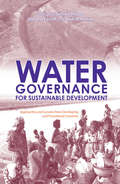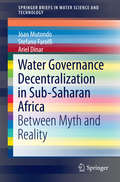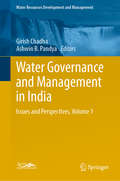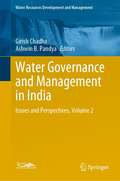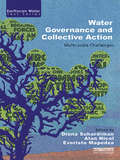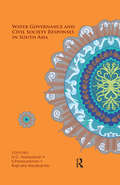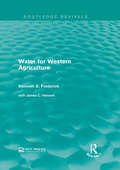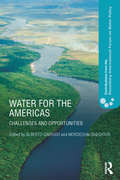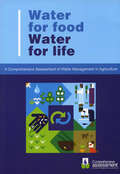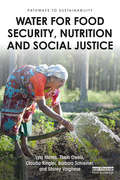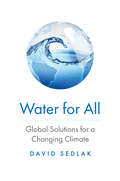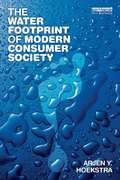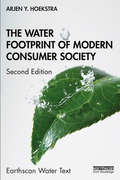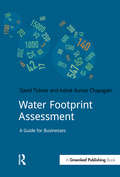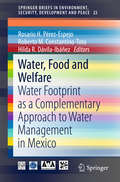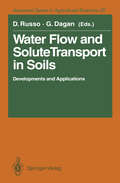- Table View
- List View
Water Governance for Sustainable Development: Approaches and Lessons from Developing and Transitional Countries
by Stefano FarolfiGood management of water resources - universally identified as a key aspect of poverty reduction, agriculture and food security - has proven, in practice, as difficult to achieve as it is eagerly sought. This book, edited and authored by leading authorities on water resource management, examines the recent changes in governance, institutions, economics and policies of water, covering developing, transitional and developed countries, with special emphasis on southern African case studies. The book examines how water policies, institutions and governance have shifted in recent years from supply-driven, quantitative, centrally controlled management to more demand-sensitive, decentralized, participatory approaches. Such a move often also implies cost recovery principles, resource allocation among competing sectors, and privatization. The case studies demonstrate that the new policies and legal frameworks have been difficult to implement and often fall short of initial expectations. Using an accessible multidisciplinary approach that integrates economics, sociology, geography and policy analysis, the book untangles the issues and presents best practices for policy- and decision-makers, governments and regulators, NGOs and user groups, service providers, and researchers. The overall aim is to show how good water governance structures can be developed and implemented for the benefit of all.
Water Governance Decentralization in Sub-Saharan Africa: Between Myth and Reality (SpringerBriefs in Water Science and Technology)
by Joao Mutondo Stefano Farolfi Ariel DinarThis book is about the process of water management decentralization in African countries, which is seen as a means of advancing river basin management at the lowest appropriate level. There are very different stages of implementing decentralization in practice. This called for research aiming to understand the following questions: (i) why do some water agencies succeed more than others? (ii) What are the variables involved in such reform process? (iii) which variables have a positive or a negative impact on the implementation of decentralization processes? (iv) Which variables could be affected by policy interventions, and how? This study aimed to answer these questions through the following objectives: (i) analyze the factors that have potentially affected the results of decentralization process in SSA basins, and (ii) analyze the performance of decentralization process in SSA basins. Qualitative and quantitative approaches were used. The main findings are that water scarcity is a major stimulus to reform; water user associations, if not well prepared and trained, may deter the decentralization process; and being part of an existing treaty over an international basin helps foster the process. Conditions improving decentralization performance include: scarcity of water resources, longer period of implementation, bottom-up creation, and appropriate budgetary support.
Water Governance and Management in India: Issues and Perspectives, Volume 1 (Water Resources Development and Management)
by Girish Chadha Ashwin B. PandyaThis book highlights the need for effective water governance in India given the fact that the country has been facing serious water stress in recent years. The water management in the country needs a serious scientific understanding coupled with the cooperative approach rather than a competitive one. It looks at current water regulations and underlines the need for overhaul of some laws to ensure that high water usage efficiency is attained, groundwater depletion is arrested and management of available resources is carried out in a disciplined manner. It also looks at the role of stakeholder engagement and pricing as a mechanism to manage demand in the wake of rapid population growth and industrialization.
Water Governance and Management in India: Issues and Perspectives, Volume 2 (Water Resources Development and Management)
by Girish Chadha Ashwin B. PandyaThis book, the second volume in the series, continues to raise contextual issues and presents perspectives regarding multifaceted challenges in management and governance of water in India. This volume attempts to broad base and expand the dialogue started in the first volume and would touch upon issues that need immediate discussion but have been left unattended like politics and management of groundwater, efficient utilization of water in agriculture (irrigation) and improving water use efficiency and building resilience. As in the first volume, this book presents a set of suggestions and recommendations in each chapter that can help frame policy guidelines in the country.
Water Governance and Collective Action: Multi-scale Challenges (Earthscan Water Text)
by Diana Suhardiman Alan Nicol Everisto MapedzaCollective Action is now recognized as central to addressing the water governance challenge of delivering sustainable development and global environmental benefits. This book examines concepts and practices of collective action that have emerged in recent decades globally. Building on a Foucauldian conception of power, it provides an overview of collective action challenges involved in the sustainable management and development of global freshwater resources through case studies from Africa, South and Southeast Asia and Latin America. The case studies link community-based management of water resources with national decision-making landscapes, transboundary water governance, and global policy discussion on sustainable development, justice and water security. Power and politics are placed at the centre of collective action and water governance discourse, while addressing three core questions: how is collective action shaped by existing power structures and relationships at different scales? What are the kinds of tools and approaches that various actors can take and adopt towards more deliberative processes for collective action? And what are the anticipated outcomes for development processes, the environment and the global resource base of achieving collective action across scales?
Water Governance and Collective Action: Multi-scale Challenges (Earthscan Water Text)
by Diana Suhardiman Alan Nicol Everisto MapedzaCollective Action is now recognized as central to addressing the water governance challenge of delivering sustainable development and global environmental benefits. This book examines concepts and practices of collective action that have emerged in recent decades globally. Building on a Foucauldian conception of power, it provides an overview of collective action challenges involved in the sustainable management and development of global freshwater resources through case studies from Africa, South and Southeast Asia and Latin America. The case studies link community-based management of water resources with national decision-making landscapes, transboundary water governance, and global policy discussion on sustainable development, justice and water security. Power and politics are placed at the centre of collective action and water governance discourse, while addressing three core questions: how is collective action shaped by existing power structures and relationships at different scales? What are the kinds of tools and approaches that various actors can take and adopt towards more deliberative processes for collective action? And what are the anticipated outcomes for development processes, the environment and the global resource base of achieving collective action across scales?
Water Governance and Civil Society Responses in South Asia
by N. C. Narayanan S. Parasuraman Rajindra AriyabanduThis book addresses paradigm shifts in water policy and governance, and examines the role of civil society organizations in influencing public policy, while focusing on social equity and democratic participation. It illustrates a range of interesting developments in policy formulation, donor–state nexus, and interventions by civil society and voluntary organizations. The collection of articles provides a comprehensive and current narrative of the state–society relations in South Asia under neoliberal governance reforms, their implications and key responses with regard to water policies. Using case studies, it closely investigates the impact, effectiveness, drawbacks and challenges faced by voluntary organizations and social movements working at various levels in the water sector. The work will interest researchers and students of development studies, environmental studies, natural resource management, water governance, and public administration, as also water sector professionals, policymakers, civil society activists and governmental and non-governmental organizations.
Water Governance and Civil Society Responses in South Asia
by N. C. Narayanan S. Parasuraman Rajindra AriyabanduThis book addresses paradigm shifts in water policy and governance, and examines the role of civil society organizations in influencing public policy, while focusing on social equity and democratic participation. It illustrates a range of interesting developments in policy formulation, donor–state nexus, and interventions by civil society and voluntary organizations. The collection of articles provides a comprehensive and current narrative of the state–society relations in South Asia under neoliberal governance reforms, their implications and key responses with regard to water policies. Using case studies, it closely investigates the impact, effectiveness, drawbacks and challenges faced by voluntary organizations and social movements working at various levels in the water sector. The work will interest researchers and students of development studies, environmental studies, natural resource management, water governance, and public administration, as also water sector professionals, policymakers, civil society activists and governmental and non-governmental organizations.
Water for Western Agriculture (Routledge Revivals)
by Kenneth D. FrederickThis title, originally published in 1982, examines the importance of western irrigation to U.S. agriculture and the impacts of the changing water supply situation on the development of western irrigation. Past trends, water supply conditions, water institutions, economic forces, technological alternatives, and environmental factors are examined for their impacts on the course of western irrigation. Water for Western Agriculture will be of particular interest for students studying environmental issues.
Water for Western Agriculture (Routledge Revivals)
by Kenneth D. FrederickThis title, originally published in 1982, examines the importance of western irrigation to U.S. agriculture and the impacts of the changing water supply situation on the development of western irrigation. Past trends, water supply conditions, water institutions, economic forces, technological alternatives, and environmental factors are examined for their impacts on the course of western irrigation. Water for Western Agriculture will be of particular interest for students studying environmental issues.
Water for the Americas: Challenges and Opportunities (Contributions from the Rosenberg International Forum on Water Policy)
by Alberto Garrido Mordechai ShechterThe chapters in this volume are peer reviewed editions of the papers presented at the 7th meeting of the Rosenberg International Forum on Water Policy which was held in Buenos Aires, Argentina on November 15-17, 2010. The theme for Forum VII was Water for the Americas: Challenges and Opportunities. This Forum was unique in examining the water problems of the Americas and identifying water management experience gleaned in other parts of the world that might be useful in addressing the problems of the Americas. The sessions illustrated how the water problems of the Americas are common problems, differing only in degree from basin to basin. There was unanimity among the participants about the need for all inhabitants of the Americas to work together to ensure that everyone has access to adequate quantities of healthy water supplies and to appropriate sanitation services. This volume’s approach is to identify different responses and policies that address common issues and learn from contrasts and experiences. The value and potential that this approach affords is that it provides critical judgments about what has worked well and what needs to be done to gain a better future for the Americas’ water resources and society. Some issues covered in the volume are so pressing and urgent, chief among them is serving the unserved, that any delays putting out new facilities in many a rural areas of Central America may cost lives and reduce the outlook for children. Additionally, the volume makes clear that the outlook for the poorest and the future of hundreds of growing cities are threatened by climate change. This book looks into the future by analyzing present and relevant data and gains insight from the different developmental stages of the hemisphere.
Water for the Americas: Challenges and Opportunities (Contributions from the Rosenberg International Forum on Water Policy)
The chapters in this volume are peer reviewed editions of the papers presented at the 7th meeting of the Rosenberg International Forum on Water Policy which was held in Buenos Aires, Argentina on November 15-17, 2010. The theme for Forum VII was Water for the Americas: Challenges and Opportunities. This Forum was unique in examining the water problems of the Americas and identifying water management experience gleaned in other parts of the world that might be useful in addressing the problems of the Americas. The sessions illustrated how the water problems of the Americas are common problems, differing only in degree from basin to basin. There was unanimity among the participants about the need for all inhabitants of the Americas to work together to ensure that everyone has access to adequate quantities of healthy water supplies and to appropriate sanitation services. This volume’s approach is to identify different responses and policies that address common issues and learn from contrasts and experiences. The value and potential that this approach affords is that it provides critical judgments about what has worked well and what needs to be done to gain a better future for the Americas’ water resources and society. Some issues covered in the volume are so pressing and urgent, chief among them is serving the unserved, that any delays putting out new facilities in many a rural areas of Central America may cost lives and reduce the outlook for children. Additionally, the volume makes clear that the outlook for the poorest and the future of hundreds of growing cities are threatened by climate change. This book looks into the future by analyzing present and relevant data and gains insight from the different developmental stages of the hemisphere.
Water for Food Water for Life: A Comprehensive Assessment of Water Management in Agriculture
by David MoldenManaging water resources is one of the most pressing challenges of our times - fundamental to how we feed 2 billion more people in coming decades, eliminate poverty, and reverse ecosystem degradation. This Comprehensive Assessment of Water Management in Agriculture, involving more than 700 leading specialists, evaluates current thinking on water and its interplay with agriculture to help chart the way forward. It offers actions for water management and water policy - to ensure more equitable and effective use. This assessment describes key water-food-environment trends that influence our lives today and uses scenarios to explore the consequences of a range of potential investments. It aims to inform investors and policymakers about water and food choices in light of such crucial influences as poverty, ecosystems, governance, and productivity. It covers rainfed agriculture, irrigation, groundwater, marginal-quality water, fisheries, livestock, rice, land, and river basins. Ample tables, graphs, and references make this an invaluable work for practitioners, academics, researchers, and policymakers in water management, agriculture, conservation, and development. Published with IWMI.
Water for Food Water for Life: A Comprehensive Assessment of Water Management in Agriculture
by David MoldenManaging water resources is one of the most pressing challenges of our times - fundamental to how we feed 2 billion more people in coming decades, eliminate poverty, and reverse ecosystem degradation. This Comprehensive Assessment of Water Management in Agriculture, involving more than 700 leading specialists, evaluates current thinking on water and its interplay with agriculture to help chart the way forward. It offers actions for water management and water policy - to ensure more equitable and effective use. This assessment describes key water-food-environment trends that influence our lives today and uses scenarios to explore the consequences of a range of potential investments. It aims to inform investors and policymakers about water and food choices in light of such crucial influences as poverty, ecosystems, governance, and productivity. It covers rainfed agriculture, irrigation, groundwater, marginal-quality water, fisheries, livestock, rice, land, and river basins. Ample tables, graphs, and references make this an invaluable work for practitioners, academics, researchers, and policymakers in water management, agriculture, conservation, and development. Published with IWMI.
Water for Food Security, Nutrition and Social Justice (Pathways to Sustainability)
by Lyla Mehta Theib Oweis Claudia Ringler Barbara Schreiner Shiney VargheseThis book is the first comprehensive effort to bring together Water, Food Security and Nutrition (FSN) in a way that goes beyond the traditional focus on irrigated agriculture. Apart from looking at the role of water and sanitation for human well-being, it proposes alternative and more locally appropriate ways to address complex water management and governance challenges from the local to global levels against a backdrop of growing uncertainties. The authors challenge mainstream supply-oriented and neo-Malthusian visions that argue for the need to increase the land area under irrigation in order to feed the world’s growing population. Instead, they argue for a reframing of the debate concerning production processes, waste, food consumption and dietary patterns whilst proposing alternative strategies to improve water and land productivity, putting the interests of marginalized and disenfranchized groups upfront. The book highlights how accessing water for FSN can be challenging for small-holders, vulnerable and marginalized women and men, and how water allocation systems and reform processes can negatively affect local people’s informal rights. The book argues for the need to improve policy coherence across water, land and food and is original in making a case for strengthening the relationship between the human rights to water and food, especially for marginalized women and men. It will be of great interest to practitioners, students and researchers working on water and food issues.
Water for Food Security, Nutrition and Social Justice (Pathways to Sustainability)
by Lyla Mehta Theib Oweis Claudia Ringler Barbara Schreiner Shiney VargheseThis book is the first comprehensive effort to bring together Water, Food Security and Nutrition (FSN) in a way that goes beyond the traditional focus on irrigated agriculture. Apart from looking at the role of water and sanitation for human well-being, it proposes alternative and more locally appropriate ways to address complex water management and governance challenges from the local to global levels against a backdrop of growing uncertainties. The authors challenge mainstream supply-oriented and neo-Malthusian visions that argue for the need to increase the land area under irrigation in order to feed the world’s growing population. Instead, they argue for a reframing of the debate concerning production processes, waste, food consumption and dietary patterns whilst proposing alternative strategies to improve water and land productivity, putting the interests of marginalized and disenfranchized groups upfront. The book highlights how accessing water for FSN can be challenging for small-holders, vulnerable and marginalized women and men, and how water allocation systems and reform processes can negatively affect local people’s informal rights. The book argues for the need to improve policy coherence across water, land and food and is original in making a case for strengthening the relationship between the human rights to water and food, especially for marginalized women and men. It will be of great interest to practitioners, students and researchers working on water and food issues.
Water for All: Global Solutions for a Changing Climate
by David SedlakA fresh look at the world’s water crises, and the existing and emerging solutions that can be used to solve them It is not your imagination: water crises are more frequent. Our twentieth-century systems for providing the water that grows food, sustains cities, and supports healthy ecosystems are failing to meet the demands of growing population and the challenges brought on by climate change. But the grim news reports—of empty reservoirs, withering crops, failing ecosystems—need not be cause for despair, argues award-winning author David Sedlak. Communities on the front lines of previous water crises have pioneered approaches that are ready to be applied elsewhere. Some have resolved shortages by enhancing water-use efficiency, and others have used moments of crisis to resolve historic disagreements over water rights. Still others have employed treatment technologies that unlock vast quantities of untapped water resources. Sedlak identifies the challenges that society faces, including ineffective policies and outdated infrastructure, and the myriad of tools at our disposal—from emerging technologies in desalination to innovations for recycling wastewater and capturing more of the water that falls on fields and cities. He offers an informed and hopeful approach for rethinking our assumptions about the way that water is managed. With this knowledge we can create a future with clean, abundant, and affordable water for all.
The Water Footprint of Modern Consumer Society
by Arjen Y. HoekstraWater is not only used in the domestic context, but also in agriculture and industry in the production of commercial goods, from food to paper. The water footprint is an indicator of freshwater use that looks at both direct and indirect use of water by a consumer or producer. The water footprint of an individual, community or business is defined as the total volume of freshwater that is used to produce the goods and services consumed by the individual or community or produced by the business. This book shows how the water footprint concept can be used to quantify and map the water use behind consumption and how it can guide reduction of water use to a sustainable level. With a number of case studies, it illustrates water use along supply chains and that water consumption at one place is often linked to water use at another. For example, it is calculated that it takes 15,000 litres of water to produce 1 kg of beef, or 8,000 litres of water to produce a pair of jeans. The book shows that imports of water-intensive products can highly benefit water-scarce countries, but also that this creates a dependency on foreign water resources. The book demonstrates how water-scarce regions sometimes, nevertheless, use lots of water for making export products. It raises the issue of sustainable consumption: how can consumers, businesses and governments get involved in reducing the water footprints of final consumer goods?
The Water Footprint of Modern Consumer Society
by Arjen Y. HoekstraWater is not only used in the domestic context, but also in agriculture and industry in the production of commercial goods, from food to paper. The water footprint is an indicator of freshwater use that looks at both direct and indirect use of water by a consumer or producer. The water footprint of an individual, community or business is defined as the total volume of freshwater that is used to produce the goods and services consumed by the individual or community or produced by the business. This book shows how the water footprint concept can be used to quantify and map the water use behind consumption and how it can guide reduction of water use to a sustainable level. With a number of case studies, it illustrates water use along supply chains and that water consumption at one place is often linked to water use at another. For example, it is calculated that it takes 15,000 litres of water to produce 1 kg of beef, or 8,000 litres of water to produce a pair of jeans. The book shows that imports of water-intensive products can highly benefit water-scarce countries, but also that this creates a dependency on foreign water resources. The book demonstrates how water-scarce regions sometimes, nevertheless, use lots of water for making export products. It raises the issue of sustainable consumption: how can consumers, businesses and governments get involved in reducing the water footprints of final consumer goods?
The Water Footprint of Modern Consumer Society (Earthscan Water Text)
by Arjen Y. HoekstraUsing the water footprint concept, this impactful book aids our understanding of how we can reduce water consumption and pollution to sustainable levels. Since the publication of the first edition, the question of how to reduce our water footprint has become even more urgent. Freshwater scarcity is increasingly perceived as a global systemic risk and overconsumption of water is widespread. The water footprint, a concept founded by the author, is an indicator of direct and indirect freshwater use by a consumer or producer that can be used to analyze water usage along supply chains and assess the sustainability, efficiency and fairness of our water use. This new edition is fully revised and updated to reflect continued developments in this rapidly growing field of knowledge. New chapters are added covering the history of the water footprint concept; the environmental footprint of the human species versus planetary boundaries; and the human right to water as a foundation to equitable sharing. All other chapters are fully revised with new findings, applications and references, including major new research on energy, vegetarian diets and intelligent water allocation over competing demands. The Water Footprint of Modern Consumer Society is a key textbook for students of interdisciplinary water studies and those taking other related courses within the environmental sciences. It will also be of interest to those working in the governmental sector, environmental and consumer organizations, the business sector and UN institutions, where there is growing interest in the water footprint concept.
The Water Footprint of Modern Consumer Society (Earthscan Water Text)
by Arjen Y. HoekstraUsing the water footprint concept, this impactful book aids our understanding of how we can reduce water consumption and pollution to sustainable levels. Since the publication of the first edition, the question of how to reduce our water footprint has become even more urgent. Freshwater scarcity is increasingly perceived as a global systemic risk and overconsumption of water is widespread. The water footprint, a concept founded by the author, is an indicator of direct and indirect freshwater use by a consumer or producer that can be used to analyze water usage along supply chains and assess the sustainability, efficiency and fairness of our water use. This new edition is fully revised and updated to reflect continued developments in this rapidly growing field of knowledge. New chapters are added covering the history of the water footprint concept; the environmental footprint of the human species versus planetary boundaries; and the human right to water as a foundation to equitable sharing. All other chapters are fully revised with new findings, applications and references, including major new research on energy, vegetarian diets and intelligent water allocation over competing demands. The Water Footprint of Modern Consumer Society is a key textbook for students of interdisciplinary water studies and those taking other related courses within the environmental sciences. It will also be of interest to those working in the governmental sector, environmental and consumer organizations, the business sector and UN institutions, where there is growing interest in the water footprint concept.
Water Footprint Assessment: A Guide for Business
by David Tickner Ashok Kumar ChapagainAs business risks associated with water intensify – for example risks to oeprations, supply chains and reputation – many corporate sustainability professionals are seeking practical tools to help them understand and assess these risks. Water Footprint Assessment tools developed primarily by the research sector are gaining attention in this context. However, there is debate among experts and non-experts about the merits of this approach. Water Footprint Assessment: A Business Guide is a concise and comprehensive digest of emerging concepts, tools and arguments around water footprint approaches. Specifically aimed at business audiences, this definitive short guide to the issues distils the latest in scientific and policy literature, helps sustainability leaders understand what they can, and can't do with water footprint tools, includes practical experience and case studies and outlines the pros and cons of using Water Footprint Assessment and similar approaches.
Water Footprint Assessment: A Guide for Business (Doshorts Ser.)
by David Tickner Ashok Kumar ChapagainAs business risks associated with water intensify – for example risks to oeprations, supply chains and reputation – many corporate sustainability professionals are seeking practical tools to help them understand and assess these risks. Water Footprint Assessment tools developed primarily by the research sector are gaining attention in this context. However, there is debate among experts and non-experts about the merits of this approach. Water Footprint Assessment: A Business Guide is a concise and comprehensive digest of emerging concepts, tools and arguments around water footprint approaches. Specifically aimed at business audiences, this definitive short guide to the issues distils the latest in scientific and policy literature, helps sustainability leaders understand what they can, and can't do with water footprint tools, includes practical experience and case studies and outlines the pros and cons of using Water Footprint Assessment and similar approaches.
Water, Food and Welfare: Water Footprint as a Complementary Approach to Water Management in Mexico (SpringerBriefs in Environment, Security, Development and Peace #23)
by Rosario Pérez-Espejo Roberto M. Constantino-Toto Hilda R. Dávila-IbáñezThis book addresses the following topics: the contemporary model for water management and alternative approaches; the socioeconomic framework, water policy and institutions; water use for food purposes, water-resources inventory and irrigation; manifestations of welfare loss and water prices; change in dietary patterns and water security; hydrological stress and pressures on water availability; groundwater management problems; vulnerability and climate change; water demand of major crops; gray water footprint and water pollution; gray water footprint and mining; virtual water and food trade; estimates of the water footprint of four key cereals, forage, livestock and bottled drinks. It is the result of a cooperation between 16 researchers from eleven Mexican academic institutions.
Water Flow and Solute Transport in Soils: Developments and Applications In Memoriam Eshel Bresler (1930–1991) (Advanced Series in Agricultural Sciences #20)
by David Russo Gedeon DaganA year has passed since Eshel Bresler, my good friend and colleague, and a member of the editorial board of the Advanced Series in Agricultural Sciences, died suddenly while on a visit to the Chinese Academy of Sciences in Beijing. We had worked together for almost 30 years at the Institute of Soils and Water, ARO, The Volcani Center at Bet Dagan. At the very beginning of our scientific careers we cooperated directly and as a result one of our first publications was coauthored (Soil Sci. 101:205-209, 1966). Thereafter, our specific research interests diver sified, but we continued to work together, with similar approaches to research, and to strive towards the development of Israel soil science and its integration into general worldwide scientific progress. I don't need to emphasize Eshel's contribution to the understan ding of the processes governing water flow and solute transport pro cesses in soils and unsaturated zones. The contributions to this Volume by such a body of outstanding scientists shows the apprecia tion of the international scientific community to his research achievements.
